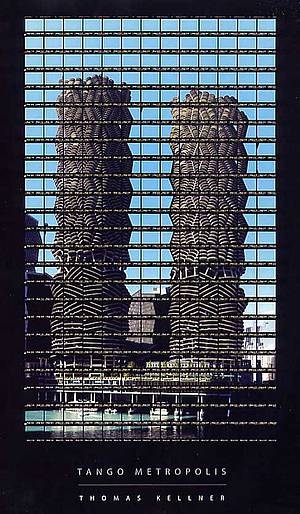Thomas Kellner 形式上的原创
介绍一只当代的搞形式的德国狼Thomas Kellner。他把德国人的精益求精用在机械式的制做方法:表现大都市的建筑由很多35mm负片底片排列,直接转印,厉害的是片片连着号(跳了号就不值钱了,跟集邮连票一样)。全部在同一时间同一角度拍摄。不经过精确的计算精密的筹划是整不出来的。
作品的收藏价值自不用说(这小子大发,已经干上curator的行当了)。至于作品含义,应该不复杂。无非是换个角度用绝对的客观记载向主观的真实性挑战。
Ditte Maria Bangsund-Pedersen : Thomas Kellner „Tango Metropolis“
Tango Metropolis, published by Galleri Image Aarhus, denmark
Is it possible to imagine a drunk building? A building dancing to the sound of a fairytale? A dizzy building? These are some of the questions that arise from Thomas Kellner’s works, works showing some of the most photographed buildings in metropolises of the world in a new and original way. It is as if Kellner gives these buildings a personalised renaissance beyond the stereotyped, mass-produced tourist images that all look the same. The result is unique. Methodically Kellner exhibits photography in an untraditional way. The contact sheet is usually the expectant in-between stage, the stage when the real picture is latent, awaiting its final enlarged development. But a closer look at Kellner’s works soon reveals the final work to be the contact sheet itself, showing the negatives in a 1:1 ratio. Furthermore the small numbers on the strips of film reveal that these images are not a collage of pasted fragments, but the exposed film in chronological order on the contact sheet. The number of exposures of a single building can range from 36 to 1296 and this determines the physical size of the work itself. The more exposures there are the more the contours of the underlying architectural structure dissolve.
This dissolution forces the viewer to consider the relationship of the works to reality. The individual exposures are not manipulated, thus each small photograph in each work is a two-dimensional impression of the three-dimensional world, just like any other non-manipulated photograph: the single exposure claims to be nothing more than one chronological element of a series. It is not until their juxtaposition on the contact sheet and in the consciousness of the viewer that the truth-value of the images is given a twist. The buildings we perceive in Kellner’s works are, after all, not the same as those we normally put in our photo albums or see in the media, and it is not difficult to categorise these shaken buildings as pure fiction. If, however, the works are located in the Cubist tradition - one of Kellner’s sources of inspiration(1) - their truth-value becomes more an issue of the viewer’s perception of these monumental buildings. Unlike the Cubists(2), Kellner does not show his buildings from more than one angle at a time. All the photographs are taken from the same point in front of the buildings. From a Cubist perspective, however, each exposure in Kellner’s works represents a frozen view of the precise part of the building the eye strikes for a single split second. That the time changes between each small image thus emphasises the Cubist thesis that three-dimensional objects – including monumental buildings – cannot be grasped at a single glance: the final whole is comprised of endless impressions of different instants. Beneath the surface of the works there is thus a subtle concurrence with the challenge to linear perspective.
By drawing attention to the actual perception of these tourist attractions Kellner also comments indirectly on the unimaginative way the average tourist sustains the same mass-produced images of the same buildings from the same angles - again and again. Kellner’s kaleidoscopic, fairytale buildings thus inject new life into timeworn tourist shots in an aesthetically arresting and technically conscious way.
With newly discovered energy the exhibition Tango Metropolis manages to shake the very foundations of these static monuments, moving beyond the evident beauty of the images themselves to query the dominance of mass (re)produced photography. Something for the tourist to have in mind next time the camera is raised to quote yet another of the photographs that has been taken endless times before. (Ditte Maria Bangsund-Pedersen, 2005)
Notes:
(1) In an interview in Rangefinder Magazine Kellner names Robert Delaunay’s cubist-related Orphist work in his Eiffel Tower series as a major source of inspiration.
(2) One of the basic principles of Cubism is to show three-dimensional objects on a two-dimensional canvas from several angles at the same time thus demonstrating that the three-dimensional cannot be captured from a single angle.
虫虎 上传了这个图片:

____________________
艺术=吃饱了撑了打的第一个响嗝(1991)
Art=Communication(1997)
艺术回归大众=大道无形(2005)
|